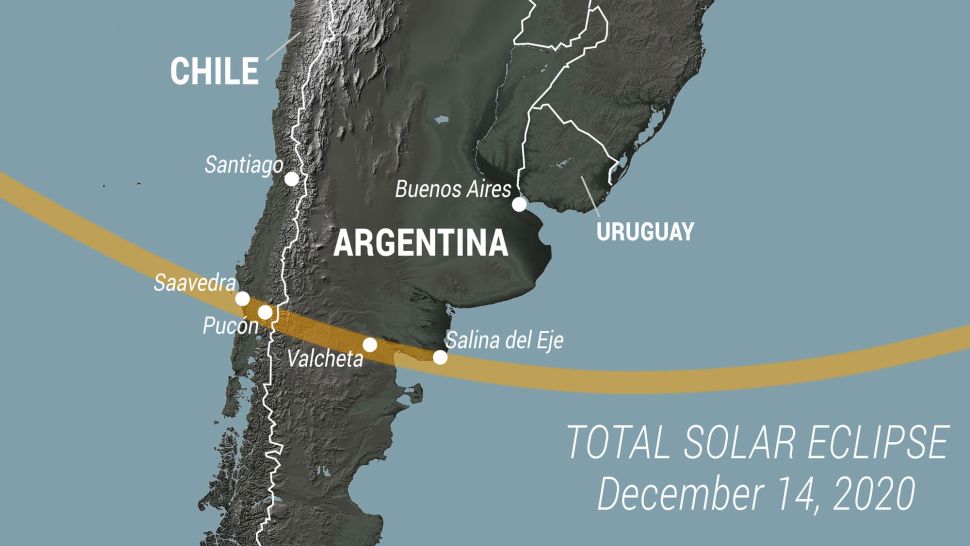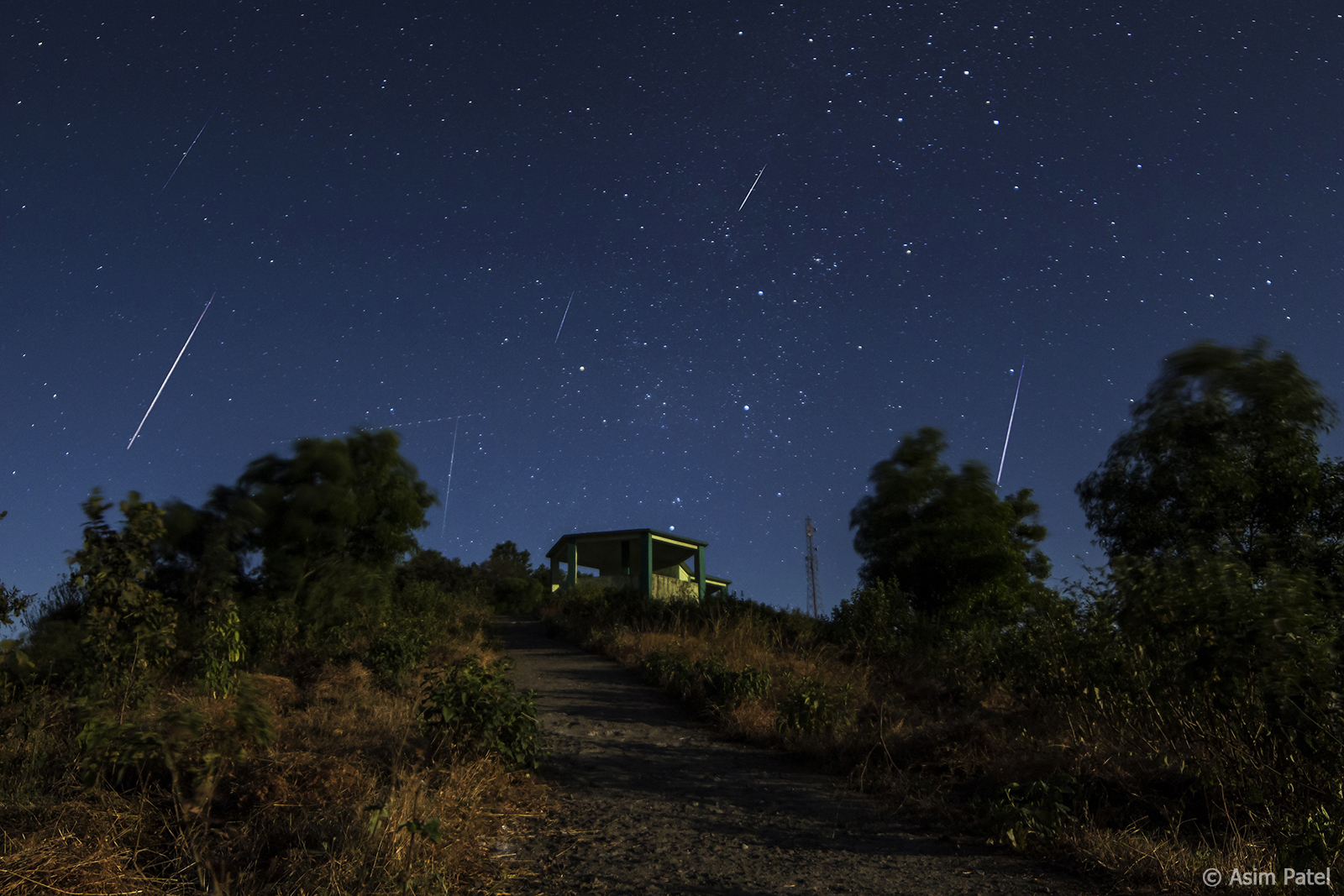2020's Only Total Solar Eclipse Will Be Visible To A Lucky Few In South America
Language
Reading Level
Listen to Article

Total solar eclipses, during which the Sun briefly "disappears" in the daytime, occur about every 18 months. However, unlike lunar eclipses, which can be seen worldwide, the celestial phenomenon can only be observed within a narrow, approximately 100-mile-wide, path of totality. Moreover, total solar eclipses occur at a specific location, on average, about every 360 years. This means that the chance to observe one in real-time is truly rare and special.
The year's only total solar eclipse, which will occur on December 14, 2020, will have a path of totality extending just 56 miles across South America — from Saavedra, Chile to Salina del Eje, Argentina. The continent's other residents and those in Southeastern Africa, including Cape Town, South Africa, will be able to observe a partial solar eclipse. The rest of the world will have to tune in to NASA TV and watch the livestreams from Pontificia Universidad Católica de Chile via telescopes at the Observatorio Docente.

A solar eclipse occurs when the Earth, Moon, and Sun align, with the Moon in the middle. However, we do not experience a total solar eclipse every time this happens because the moon’s elliptical orbit causes its distance from Earth to vary between 221,500 miles to 252,000 miles. For a total eclipse to occur, the Moon has to be at its closest orbital distance (so it appears larger than the Sun), and in perfect line with the Earth and the Sun.
Those able to experience the total eclipse can expect to see surreal darkness creep towards and over them as the satellite positions itself perfectly between the Sun and the Earth. Once the Sun is completely concealed, they will witness a breathtaking sight of its corona, or atmosphere, and bright stars during the middle of the day, albeit for just a few minutes. Fleeting as they are, total solar eclipses provide researchers an opportunity to conduct experiments to solve mysteries such as why the Sun is so hot or the cause of the unpredictable, and often dangerous, solar flames that emanate from its surface.
If you are among the lucky few in the path of this year's solar eclipse — total or partial — be sure to wear special glasses to protect your eyes from the Sun's harmful infrared and ultraviolet radiation, which can result in permanent damage or even blindness.
Geminid Meteor Shower

Those unable to see the solar eclipse can seek out the annual Geminid meteor shower, which will peak the night of Sunday, December 13, through dawn of Monday, December 14, 2020. Called the “900-pound gorilla of meteor showers” by NASA, the shooting stars rank high in both quantity and quality. They are also easier to observe than other meteor showers because they fly across the skies at a noticeably slower pace, encountering Earth at about 22 miles (35 kilometers) per second, or about half the speed of the Perseids meteors’ 37 miles (60 kilometers) per second.
Named after the constellation Gemini, from which they appear to radiate, the Geminids are the result of particles left behind by 3200 Phaethon. The space object, which demonstrates characteristics of both comets and asteroids, orbits the Sun every 1.4 years and comes so close to the star that its surface gets heated to about 1500°F (800°C). This causes it to shed rocky debris the size of sand grains or peas. Over the centuries, the tiny 3200 Phaethon specks have formed a “river of rubble” along its orbit. As Earth traverses through the area every year in mid-December, the particles collide with our planet’s outer atmosphere and burn, transforming into gorgeous “shooting stars.”

For those planning to brave the freezing winter mornings to watch this year’s final celestial show, here are some tips from experts: bundle up, pack some hot cocoa, get as far away as possible from city lights, and, most important of all, be patient. That’s because the shooting stars do not come at regular intervals. Instead, they tend to zip across the skies in clumps, about every five to seven minutes.
Happy Viewing!
Resources: Space.com, Earthsky.com, travelandleisure.com

Get the Workbook for this article!
Workbook contains: Article, Reading Comprehension, Critical Thinking Questions, Vocabulary in Context (+ answers), Multiple Choice Quiz (+ answers), Parts of Speech Quiz (+ answers), Vocabulary Game (+ answers)Cite Article
Learn Keywords in this Article
152 Comments
- god_kid772about 4 yearsi wish i can see that wow what i can now
- arianagrandeismabout 4 yearsi wish i lived in south america so i could see it :(
- sokeefe_foreverabout 4 yearsSame... Live in North America though.
- phantomdancing2about 4 yearsme too...
- lokitosa-160347156658about 4 yearsI saw an eclipse happen a few years ago at my house wish everyone could see it it was so cool. But the meteor showers not missing them totally going.
- sokeefe_foreverabout 4 yearsI live in North America. They are super lucky! I saw an eclipse a few years, but it was only a partial eclipse. I think there's supposed to be a full eclipse bear where I live in 2024 or something. Just under 4 years away!
- ogbots2about 4 yearsI remember when i saw an eclipse but I'm not going to be able to see this one I don't live in south America
- 161327about 4 yearsCool!
- ultrajangoabout 4 yearsI saw the meteor shower last night, I saw four meteors.
- caitisconerabout 4 yearsCool!!!!!!! You are LUCKY ¡!!!!
- gamergirl717about 4 yearsI've never seen a solar eclipse or a meteor shower
- determinedowl23about 4 yearsWow, that sounds amazing! I've never seen a total eclipse, but I saw a partial eclipse a couple years ago. I'm gonna watch the Geminids, though. Don't forget that Saturn and Jupiter are gonna align soon (or something like that lol)!
- brooklynjabout 4 yearsOMG! I saw the shooting stars it was a dream that happened yesterday! So we grabed stacks and waited for it to be 10:00 and then we drove far away I was looking out side my window while we were driving I saw tiny REALLY TINY red dots fly accross the sky BUT THEN I saw a desent size one fly fast accross the sky! Then we finally reached were we were going we so so many they just flew by I WAS ABOUT TO CRY! there was so many stars in the sky there was no moon you there was every star the stars was what was lighting the sky up it was so burtiful the first star I was was Ryans belt its the three stars in a row and then you could see his body once you see his Belt! My dad was not looking well but he said he wanted to see one with the fog behind it while he said that I was looking at Ryans belt I was ontop of the car btw and then I saw 5 desent ones in a row fly by then the entire place gasped at this huge on flew bye leaving so much smoke behind then POOF disapeared! Then another one flew by
- brooklynjabout 4 yearssorry it was too long I could not finish! Like I was saying another flew by it was even bigger it was huge I GASPED we styaed there for 2 hours freezing but it was worth it! btw the sun is a star it is not the biggest star the biggest star is Sirius bigger than the sun if Sirius replaces the sun we will all be dead because it would milt all planets thats how bright it is!
- yeyejusaeeabout 4 yearssirius is not the biggest star its UY Scuti
- pasteleaabout 4 yearsMy dad drove 10-12 hours just to see it.
- blackkingabout 4 yearsI never saw a solar eclipse too but I think it's cool.




